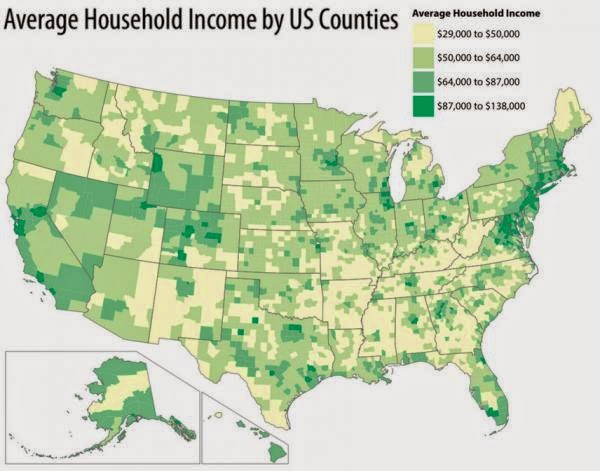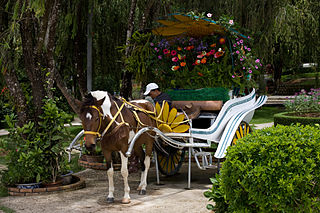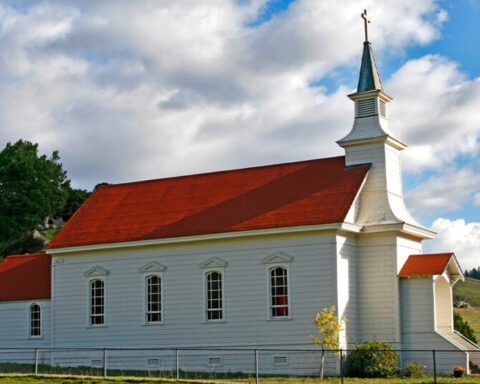One thing odd you might notice about the above income map from Visualizing Economics is the extent to which it corresponds to the map of US population density. The DC to NY corridor, one of the most heavily populated areas in the nation, is also among the highest in income, as is San Fran, Chicago, and Denver. So one might be tempted to think that if one wants to live well, then high population density areas are the places to move. After all, one can live 50% better on $90k than $60k, right? It’s just simple math.
Except that it’s not. I remember as teeny little programmer flying to NYC to do some software installation and to train users on how to use a dialup modem. 2400 baud, baby. The thing that stuck with me from that trip was not that NYC smelled just like the first diaper of the morning, but that a software guy with whom I was talking told me his one bedroom apartment cost $1500 a month.
At the time I lived in a newer 5-br house on acreage that never came close to $1500 a month, even with interest rates twice what they are today. Yes, he made twice the money I did. And I lived better by just about any objective measurement.* He paid more taxes, far more rent, more for food and transportation. I thought at the time that I could have lived just as poorly as him on half of what I made. It’s probably not true, but it’s not wholly false, either.
What has that to do with SHTF? Plenty, actually. While it’s great to have a high income, if you live in an area where ordinary costs eat that income up, all you have at the end of the day is bragging rights over your redneck competitors. And when income disappears, those costs remain, dragging hordes of indebted, high-maintenance people underwater very quickly. While prices will (because they must) eventually adjust to reality, it is harder for costs to fall than rise: every government program is geared toward making your life more costly.**
But where income is already low, it has less room to fall, so to speak. People are used to getting along with less cash, but they have more real assets they can fall back on and fewer people competing for them. As food prices continue to rise, backyard gardens in tan areas expand, but they still needn’t be guarded.
Our current income structure is wholly supported by cheap energy and financial shenanigans, and when those end, income will become less important than access to real assets. Those assets are not only better in tan areas, they are generally cheaper as well. If you can manage a green income while living in a tan area, you can gain control of plenty of worthwhile assets in short order. Besides, if you want to live twice as well as everyone around you, that’s easier to pull off among wrestling fans than among fans of Cats anyway.
* I didn’t have Broadway next door and he did. For some reason, both of us counted that as a win.
** For example, the government creates ‘affordable housing’ not by allowing house prices to fall, but by propping them up while subsidizing loans on those houses for people who cannot afford them at the new, higher prices.

Where to Live XIII – Green Living in Tan Country
5 Comments
Leave a Reply
Latest from Family

“Joseph” by Charles Kingsley
Editor’s note: The following is extracted from The Works of Charles Kingsley, Vol. 25 (published 1885). (Preached on the Sunday before the Wedding of the Prince of Wales. March 8th, third Sunday

Fly, Fly Dear Friend
It is with heavy heart that we report that our good friend and MOTW Poet Laureate, Ian McLeod, has passed away. He was too young, and he will be dearly missed. Offer

You Can’t Have Both Feminism and Chivalry
If women are not weaker than men there is zero reason to “protect” or “let them go first” or “open the door for them.” Now because I’m dead set against feminism, I

A Place for Everyone
If you ever played any team sports, you’ll be familiar with motivational quotes. Successories kicked things off in 1985 as a catalog company. There are entire campaigns and web sites devoted to

Church Home
That older single lady with the grey hair and quirky dress. The men stuffing themselves into old suits a size and a half too small or the old men whose suits now




5
3
Now one might want to make a comparative map showing cost of living in these areas as well. I wonder how that would overlay on this?
But then I suspect you already know the answer to that question.
The cost of living in an area is primarily a function of the ability of people living there to pay. A Manhattan in a Manhattan bar is twice as much as a cocktail in Huntsville.
4.5